What is Go?
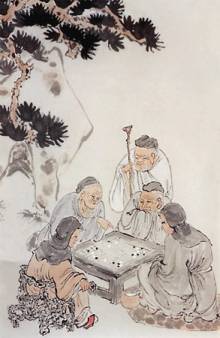
Go is a fascinating board game. It is older than chess - it is the oldest board game among those still played today.
Go is the Japanese name for the game. Other names for Go are: Igo (alternate Japanese name), Weiqi or Weichi (Chinese names), and Baduk (Korean name).
There is also a "poetic" name for it: Ranka. Ranka, in Japanese, means "rotten axe handle", and it comes from the following legend:
A woodcutter stopped by to watch a game of Go played by two mountain sages. When the game finished, so much time had passed that he found that the handle of his axe had rotted away.
Why play Go?
- Go has very simple rules, but very subtle strategy. Some enjoy it as a competitive game, others treat it as a martial art.
- Go is a constructive game: one learns how to develop and share profit, not destroy the opponent.
- Go is a great game for everybody: it teaches us to be patient, to concentrate, plan, be organized and competitive while respectful. It keeps the brain active at any age.
- Go helps making new friends either in a local club, or all over the world since a lot of people play Go on the internet.
Brief history
Go was invented in China about four thousand years ago. It was then imported in Japan, where it became a game of the noblemen and samurai.
After the World War II, Go became more and more popular outside of Asia as well - but there is still a very big gap in strength between non-Asian, amateur players and Asian professional Go players.
Over the last decade or so, the international Go scene has been dominated by Korea and China, closely followed by Japan.
A very entertaining way to find out about the world of Go in Asia is to read the Hikaru no Go manga or to watch the Hikaru no Go series.
Here is a short video documentary about Go in modern Japan:
While Go used to be the game of the samurai in ancient Japan, it is really a very popular international game nowadays.
Very simple rules
The rules of Go are so easy and intuitive that even very young children can learn them in a matter of minutes. There ia a very nice interactive Go tutorial online. Otherwise you can read the rules in the next few paragraphs.
Basic
Go is played by 2 opponents, on a 19x19 grid board (by the way, there are 19 x 19 = 361 intersection points on the board, therefore the name of this website). However, playing on smaller boards is also possible (of which 9x9 and 13x13 are common).
There are 181 black stones and 180 white stones. Black plays first.
The two opponents play alternatively, one move each time. A move consists of placing a stone on an empty intersection.
Once placed on the board, stones don't move (other than getting captured and eliminated from the board).
Capture
Sometimes, as a result of one's move, one or more of the opponent's stones get to have no liberty. In such a case, all stones with no liberty are captured and eliminated from the board for the rest of the game.
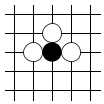 Dia 1
Dia 1
For instance, if it is White's turn to play in dia 1...
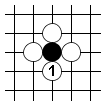 Dia 2
Dia 2
...he can surround the lonely black stone by playing at 1 in dia 2.
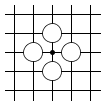 Dia 3
Dia 3
As a result, the last of the 4 liberties of the black stone is filled, so that stone is captured and removed from the board.
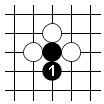 Dia 4
Dia 4
If it was Black's turn to play in dia 1, then he could play at 1 in dia 4 and escape capture for now. The two black stones act as a group now, and they have 3 liberties.
Cannot recapture immediately
There is a special rule related to situations that might lead to an infinite game. An example is best to explain it.
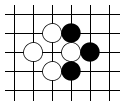 Dia 5
Dia 5
Suppose the situation in dia 5 just occurred on the board, and it is Black's turn next. Black can capture one white stone. If he does that, then White is not allowed to recapture immediately - because that would let back to dia 5, and the game would never end. This situation is called "KO" in Japanese.
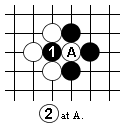 Dia 6
Dia 6
Here in dia 6 we show Black 1 capturing the white stone marked with A. White is not allowed to play 2 in the empty place left after A was captured - White has to play 2 somewhere else on the board, and if Black doesn't fill at A immediately, then White can come back and capture at A. Of course, the rule applies to both players, none of them are allowed to recapture immediately in a KO fight.
Territory
The goal of the game is to surround territory (empty board locations). In the end of the game, when both players pass, territories are counted and the winner is decided. Captured stones are placed inside matching color territories in the counting phase, so each captured stone values one point of territory.
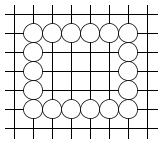 Dia 7
Dia 7
For instance, in dia 7 White has surrounded 12 points in the center of the board. White had to surround the territory on all 4 directions, so he used 18 stones to do that.
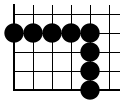 Dia 8
Dia 8
In dia 8, Black has also surrounded 12 points, but in the corner of the board. Since the sides of the board can be used as territory boundaries, Black only had to close it from only 2 directions, so he used 8 stones for that.
Very complex strategy
It is not easy at all to play Go well. They say that while one can learn the rules in 3 minutes, it will take 30 years to be a master.
This is not meant to discourage anyone - Go can be enjoyed at any level. It also has a handicap system, which makes the game fair even when the 2 opponents have very different skill levels.
